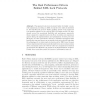345 search results - page 60 / 69 » When Systems Loose their Identity |
BMCBI
2007
13 years 7 months ago
2007
Background: Safety assessment of genetically modified (GM) food, with regard to allergenic potential of transgene-encoded xenoproteins, typically involves several different method...
BMCBI
2011
13 years 2 months ago
2011
Background: Remote homology detection is a hard computational problem. Most approaches have trained computational models by using either full protein sequences or multiple sequenc...
WWW
2002
ACM
14 years 8 months ago
2002
ACM
Aliasing occurs in Web transactions when requests containing different URLs elicit replies containing identical data payloads. Conventional caches associate stored data with URLs ...
DEXA
2009
Springer
14 years 2 months ago
2009
Springer
Abstract. Fine-grained lock protocols should allow for highly concurrent transaction processing on XML document trees, which is addressed by the taDOM lock protocol family enabling...
SP
2008
IEEE
14 years 2 months ago
2008
IEEE
Decentralized distributed systems such as peer-to-peer systems are particularly vulnerable to sybil attacks, where a malicious user pretends to have multiple identities (called sy...

